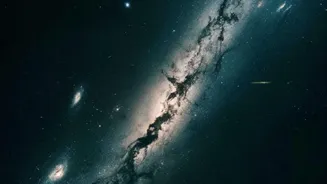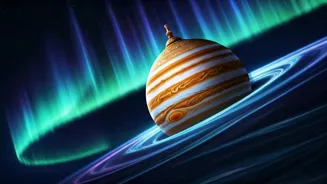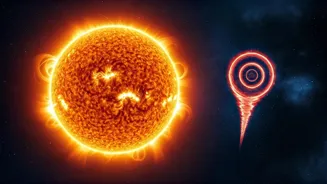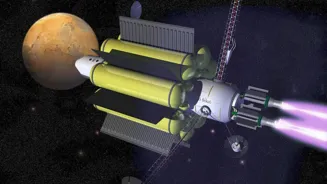Unveiling the Mysteries of the Cosmic Microwave Background Radiation: A Window to the Universe's Birth and Destiny. Explore more!
Have you ever wondered about the origins of the universe? Scientists have
been probing the deepest mysteries of existence, and one of the most important clues they have discovered is the Cosmic Microwave Background (CMB) radiation.
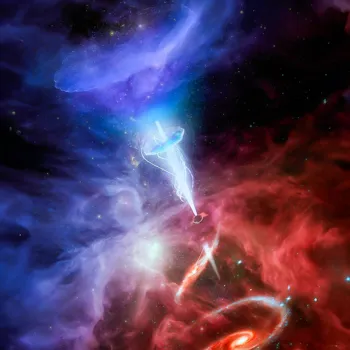
This faint glow permeates the entire universe and holds invaluable information about its earliest moments. Imagine it as a baby picture of the cosmos, taken a mere 380,000 years after the Big Bang!
Accidental CMB discovery leads to Big Bang evidence, Nobel Prize
The CMB was accidentally discovered in 1965 by two American radio astronomers, Arno Penzias and Robert Wilson. They were working at Bell Telephone Laboratories, trying to improve microwave communication.
No matter where they pointed their antenna in the sky, they kept picking up a persistent, uniform background noise. Initially, they suspected it was due to equipment malfunction or even bird droppings in the antenna!
However, after careful investigation and consultation with other scientists, they realized they had stumbled upon something far more significant. They had found evidence of the Big Bang and the afterglow of the universe's fiery birth.
This discovery earned them the Nobel Prize in Physics in 1978, solidifying the CMB's importance in cosmology. The CMB is like a universal echo, a whisper from the distant past, allowing scientists to piece together the puzzle of cosmic evolution.
Early universe: dense particles; light trapped; recombination led to CMB
Imagine the early universe as an incredibly hot, dense soup of particles – protons, neutrons, and electrons – all bouncing around in a chaotic frenzy. Light, in the form of photons, was constantly interacting with these particles, preventing it from travelling freely.
It was like being trapped in a dense fog. As the universe expanded and cooled, everything eventually reached a tipping point. Around 380,000 years after the Big Bang, the temperature dropped to a point where electrons could combine with protons to form neutral hydrogen atoms.
This event, known as recombination, allowed photons to finally stream freely through space. These photons, released during recombination, are what we observe today as the CMB.
Because the universe has been expanding ever since, the wavelengths of these photons have been stretched, shifting them from the visible light spectrum into the microwave spectrum. This stretching and cooling are why the CMB is so faint and cold today, only a few degrees above absolute zero.
The CMB's uniformity reveals early universe's structure seeds
The CMB is incredibly uniform, meaning its temperature is almost the same in every direction we look. However, there are tiny temperature fluctuations, variations of only a few parts per million.
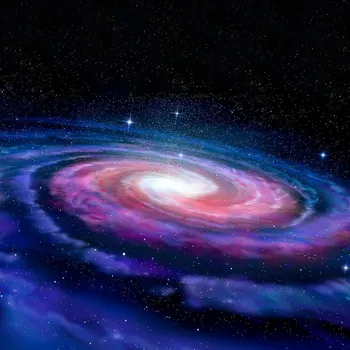
These subtle differences are incredibly important because they represent the seeds of all the structures we see in the universe today – galaxies, clusters of galaxies, and even the voids between them. These fluctuations were caused by tiny density variations in the early universe.
Regions with slightly higher density had a stronger gravitational pull, attracting more matter. Over billions of years, these denser regions grew, eventually collapsing to form the structures we observe today.
The CMB is like a blueprint, revealing where and how these structures began to form, offering insights into the universe's evolution.
Analysing these fluctuations allows scientists to learn about the composition of the universe, the age of the universe, and even the laws of physics that governed its earliest moments.
Scientists study CMB with advanced instruments, revolutionizing cosmology
Scientists use sophisticated instruments to study the CMB. Telescopes like the Wilkinson Microwave Anisotropy Probe (WMAP) and the Planck satellite have mapped the CMB with unprecedented accuracy, providing detailed information about these tiny temperature fluctuations.
These telescopes are often placed in space to avoid the interference from the Earth's atmosphere, which can distort the signals. The data collected from these missions have revolutionized our understanding of cosmology.
By analyzing the patterns in the CMB, scientists can determine the age of the universe, which is estimated to be around 13.8 billion years.
They can also determine the composition of the universe, which is made up of about 5% ordinary matter (like atoms), 27% dark matter (an invisible substance that interacts through gravity), and 68% dark energy (a mysterious force that is causing the universe to expand at an accelerating rate).
These findings have profound implications for our understanding of the universe and our place within it. The CMB acts as a cosmic laboratory, allowing scientists to test fundamental theories of physics and refine our models of the universe.
Studying CMB unveils universe's mysteries, dark energy, inflation, and fate
Studying the CMB is not just about understanding the past, it is also about understanding the future of the universe. By carefully analyzing the CMB, scientists are attempting to unravel the mysteries of dark energy and dark matter.
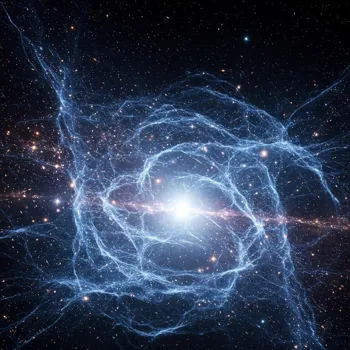
These enigmatic substances play a dominant role in guiding the fate of existence. Understanding the basic physics of dark energy is definitely fundamental to finding out whether the universe will continue to expand indefinitely or whether it will someday slow down and begin to compress.
Furthermore, scientists are searching for evidence of inflation, a period of extremely rapid expansion that occurred in the first fraction of a second after the Big Bang.
Detecting signatures of inflation in the CMB would provide further support for this theory and give us valuable insights into the physics of the universe at the highest energy scales.
Ongoing research into the CMB promises to reveal even more profound insights into the origins, evolution, and fate of the universe. It is a field of active research with new discoveries being made all the time.

